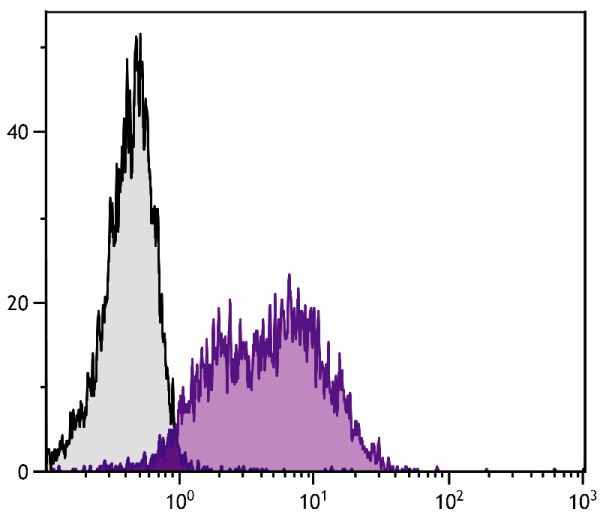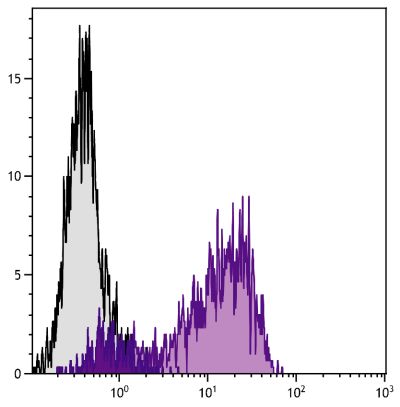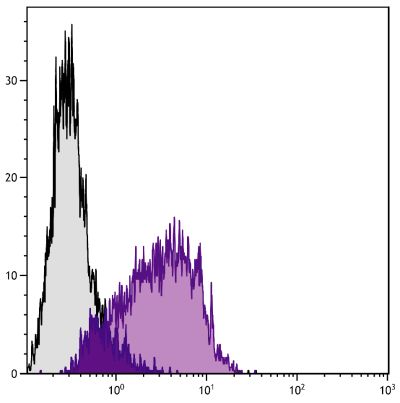Mouse Anti-Human CD54-PE (15.2)
Cat. No.:
9441-09
PE Anti-Human CD54 antibody for use in flow cytometry assays.
$249.00


| Clone | 15.2 |
|---|---|
| Isotype | Mouse (BALB/c) IgG1κ |
| Isotype Control | Mouse IgG1-PE (15H6) |
| Specificity | Human/Porcine CD54 |
| Alternative Names | ICAM-1, intracellular adhesion molecule-1, Ly-47 |
| Description | CD54, also known as intercellular cell adhesion molecule-1 (ICAM-1), is a 90 kDa type I transmembrane glycoprotein and a member of the immunoglobulin superfamily. It exhibits a wide tissue distribution being expressed on both hematopoietic and non-hematopoietic cells. ICAM-1 expression on leukocytes is low but is rapidly upregulated upon activation. Expression on endothelium and other non-hematopoietic cells is strongly upregulated by inflammatory mediators. The ligands of CD54 are CD11a/LFA-1α and CD11b/Mac-1α. Endothelial CD54 contributes to the extravasation of leukocytes from blood vessels particularly in areas of inflammation. CD54 on antigen-presenting cells (APC) contributes to antigen-specific T cell activation presumably by enhancing interactions between T cells and APC. |
| Immunogen | Rheumatoid synovial cells and human monocytes |
| Conjugate | PE (R-phycoerythrin) |
| Buffer Formulation | Phosphate buffered saline containing < 0.1% sodium azide and a stabilizer |
| Clonality | Monoclonal |
| Concentration | Lot specific |
| Volume | 1.0 mL |
| Recommended Storage | 2-8°C; Avoid exposure to light; Do not freeze |
| Applications |
Flow Cytometry – Quality tested 14-17 Immunohistochemistry-Frozen Sections – Reported in literature 1-3 Immunocytochemistry – Reported in literature 4,18 Immunoprecipitation – Reported in literature 7 Western Blot – Reported in literature 5 Blocking – Reported in literature 6,8,9 Neutralization – Reported in literature 7 ELISA – Reported in literature 10-13 |
| RRID Number | AB_2796799 |
| Gene ID |
3383 (Human) 396750 (Porcine) |
| Gene ID Symbol |
ICAM1 (Human) ICAM1 (Porcine) |
| Gene ID Aliases | BB2; CD54; P3.58; ICAM-1 |
| UniProt ID |
P05362 (Human) |
| UniProt Name |
ICAM1_HUMAN (Human) |
Documentation
Certificate of Analysis Lookup
Enter the Catalog Number and Lot Number for the Certificate of Analysis you wish to view
- 1. Norton J, Sloane JP, Al-Saffar N, Haskard DO. Expression of adhesion molecules in human intestinal graft-versus-host disease. Clin Exp Immunol. 1992;87:231-6. (IHC-FS)
- 2. Bloom S, Simmons D, Jewell DP. Adhesion molecules intercellular adhesion molecule-1 (ICAM-1), ICAM-3 and B7 are not expressed by epithelium in normal or inflamed colon. Clin Exp Immunol. 1995;101:157-63. (IHC-FS)
- 3. Sousa AR, Lane SJ, Atkinson BA, Poston RN, Lee TH. The effects of prednisolone on the cutaneous tuberculin response in patients with corticosteroid-resistant bronchial asthma. J Allergy Clin Immunol. 1996;97:698-706. (IHC-FS)
- 4. Lin Y, Weisdorf DJ, Solovey A, Hebbel RP. Origins of circulating endothelial cells and endothelial outgrowth from blood. J Clin Invest. 2000;105:71-7. (ICC)
- 5. Grewe M, Stege H, Vink A, Klammer M, Ruzicka T, Roza L, et al. Inhibition of intercellular adhesion molecule-1 (ICAM-1) expression in ultraviolet B-irradiated human antigen-presenting cells is restored after repair of cyclobutane pyrimidine dimers. Exp Dermatol. 2000;9:423-30. (WB)
- 6. Berendt AR, McDowall A, Craig AG, Bates PA, Sternberg MJ, Marsh K, et al. The binding site on ICAM-1 for Plasmodium falciparum-infected erythrocytes overlaps, but is distinct from, the LFA-1-binding site. Cell. 1992;68:71-81. (Block)
- 7. Rizzuto CD, Sodroski JG. Contribution of virion ICAM-1 to human immunodeficiency virus infectivity and sensitivity to neutralization. J Virol. 1997;71:4847-51. (IP, Neut)
- 8. Duperray A, Languino LR, Plescia J, McDowall A, Hogg N, Craig AG, et al. Molecular identification of a novel fibrinogen binding site on the first domain of ICAM-1 regulating leukocyte-endothelium bridging. J Biol Chem. 1997;272:435-41. (Block)
- 9. Porter JC, Falzon M, Hall A. Polarized localization of epithelial CXCL11 in chronic obstructive pulmonary disease and mechanisms of T cell egression. J Immunol. 2008;180:1866-77. (Block)
- 10. Chen K, Reece LM, Leary JF. Mitochondrial glutathione modulates TNF-α-induced endothelial cell dysfunction. Free Radic Biol Med. 1999;27:100-9. (ELISA)
- 11. Kalogeris TJ, Kevil CG, Laroux FS, Coe LL, Phifer TJ, Alexander JS. Differential monocyte adhesion and adhesion molecule expression in venous and arterial endothelial cells. Am J Physiol. 1999;276:L9-19. (ELISA)
- 12. Kalogeris TJ, Laroux FS, Cockrell A, Ichikawa H, Okayama N, Phifer TJ, et al. Effect of selective proteasome inhibitors on TNF-induced activation of primary and transformed endothelial cells. Am J Physiol. 1999;276(4):C856-64. (ELISA)
- 13. Chen K, Chang BH, Younan P, Shlykov SG, Sanborn BM, Chan L. Increased intracellular calcium transients by calmodulin antagonists differentially modulate tumor necrosis factor-α-induced E-selectin and ICAM-1 expression. Atherosclerosis. 2002;165:5-13. (ELISA)
- 14. Franken M, Devergne O, Rosenzweig M, Annis B, Kieff E, Wang F. Comparative analysis identifies conserved tumor necrosis factor receptor-associated factor 3 binding sites in the human and simian Epstein-Barr virus oncogene LMP1. J Virol. 1996;70:7819-26. (FC)
- 15. Yamazaki K, Spuill G, Rhoderick J, Spielman J, Savaraj N, Podack ER. Small cell lung carcinomas express shared and private tumor antigens presented by HLA-A1 or HLA-A2. Cancer Res. 1999;59:4642-50. (FC)
- 16. Varas A, Jiménez E, Sacedón R, Rodríguez-Mahou M, Maroto E, Zapata AG, et al. Analysis of the human neonatal thymus: evidence for a transient thymic involution. J Immunol. 2000;164:6260-7. (FC)
- 17. Hernández-Lopez C, Valencia J, Hidalgo L, Martínez VG, Zapata AG, Sacedón R, et al. CXCL12/CXCR4 signaling promotes human thymic dendritic cell survival regulating the Bcl-2/Bax ratio. Immunol Lett. 2008;120:72-8. (FC)
- 18. Edamura K, Nasu K, Iwami Y, Nishimura R, Ogawa H, Sasaki N, et al. Effect of long-term culture on the expression of antigens and adhesion molecule in single porcine pancreatic endocrine cells. Xenotransplantation. 2005;12:327-32. (ICC, Porcine Reactivity)
See More






